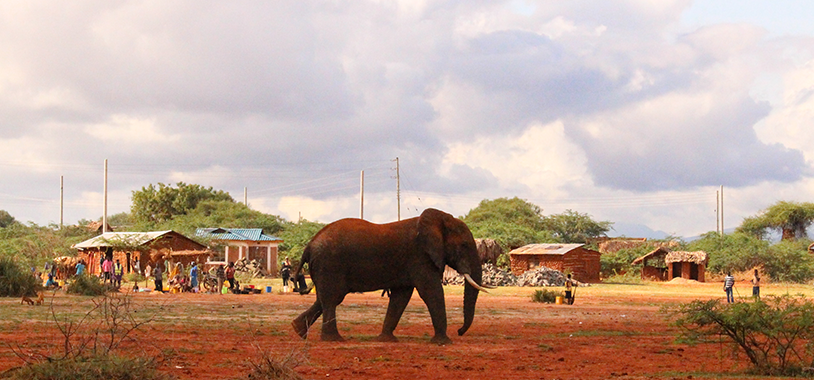On the shores of Lake Jipe, which straddles the border between Kenya and Tanzania, an uneasy standoff persists—not between belligerent armies, but humans and elephants. In this area, which is on the western boundary of Kenya’s Tsavo West National Park, elephants make daily visits to the lake to eat the reeds that grow near the shore. After spending most of the day feeding, the elephants make their way inland along a route that takes them within a stone’s throw of several local villages, where locals watch them warily.
To conservationists and tourists, the elephants are magnificent. To many villagers, who depend on the lake to fish for tilapia, attitudes towards the elephants range from annoyed indifference to outright fear. Wanting to better understand how the local denizens perceive the animals, researchers working with Save the Elephants conducted surveys; they published their results in Pachyderm.
“The paper really highlights how it’s so important to understand the feelings of people who live with elephants,” said study co-author Dr Lydia Tiller, STE’s Tsavo Research Manager. “That’s really crucial for elephant conservation.”
In 2018, STE began fitting elephants in Tsavo with radio collars to track their movements and better understand human-elephant conflict. They discovered that the elephants were impacting local people’s lives. That led them to investigate the locals’ attitudes toward the animals.
“A lot of people in the West really love elephants,” Tiller said. “But if we don’t understand the feelings of the people who actually live with elephants, whose everyday reality can be problematic elephants, then any interventions that we make will fail.” Occasionally, conservation groups come into areas where human-animal conflict exists, but don’t make an effort to understand how locals feel about the very animals they’re trying to save, she added.
Tiller and her colleagues conducted questionnaires of 63 residents of three fishing villages in the area, and carried out fifteen additional interviews with key members of the area. They also spoke to two representatives of the Kenya Wildlife Service. They combined the findings of the interviews with tracking data from a bull elephant named Manolo, whom the researchers had collared in 2018.
The majority of people Tiller and her colleagues spoke to said they saw elephants every day, adding that their presence has become more common in recent years. The tracking data supported those assertions: Manolo spent a great deal of time along Jipe’s shoreline, and regularly travelled near or directly through the villages there.
Some of the respondents said they felt privileged to live near elephants and even like seeing them, despite being afraid. Many more, however, said they saw no benefits from having elephants around, and that the animals made their lives harder. Tiller said that villagers sometimes had difficulty fishing, because Manolo and his comrades were in the way. The villagers also said elephants have lately gotten more aggressive, and there had been instances of elephants injuring people.
Despite these issues—and the communities’ varied attitudes about them—people living near Lake Jipe appear to live in a state of passive coexistence with the elephants. They have never killed an elephant in retaliation, for example. That places them at about the middle of what researchers call the conflict-to-coexistence continuum, a framework for understanding human-animal interactions. But the community are “very much at a tipping point on this continuum,” Tiller said. Pollution and overfishing of Jipe threaten their livelihood—the lake’s tilapia—and they live on the brink of poverty. And many blame the elephants for preventing them from farming: “I don’t like to live with elephants because they threaten our lives, and destroy our crops,” said one respondent. “We have land but we cannot use it. There is no fence and there is no way for us to protect our crops.”
The people also feel forgotten by the government and conservationists alike. “If an elephant is poached, helicopters and park rangers come in, and are really upset about an elephant being killed,” Tiller explained. “But if someone’s injured or killed by an elephant, a helicopter never arrives and they feel no one cares about them.” That contrast doesn’t help their tolerance of the animals or wildlife authority.”
Tiller said she hopes to share the study results with other organizations in the Jipe area to help them come up with solutions for the villagers that will prevent an escalation of conflict with the elephants. Those might include alternatives to fishing or traditional farming, such as beekeeping, expanding tourism, or planting crops the elephants don’t like to eat, like sunflowers.
Iain Douglas-Hamilton, STE’s founder, often says that the conservation of elephants will depend on how people feel and think about elephants. The new study is a major step in understanding that. “We really have to find ways to promote coexistence, and understand the community perspective and the behaviour of the elephants,” said Douglas-Hamilton. It’s a start.
Top image: Manolo walking in front of a house in Lake Jipe, 2019 © Naiya Raja


